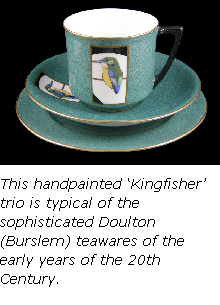
Information on the histories of UK potters and pottery manufacturers from 1900 to the present day
Copyright © Michael Perry 2010

Doulton wares
The Doulton (Burslem) wares are so diverse and so vast in number that specialist publications should be referred to. This applies especially to the series ware.
Lambeth stoneware
The Lambeth stoneware is exceptionally diverse and highly collectible. Most marks include the words 'Doulton Lambeth' and many pieces are signed or initialled by the artist responsible.
In 1974, Doulton introduced 'Lambeth Stoneware' a casual tableware brand in an oven and freezer proof stoneware body.
Burslem decorative porcelains
Doulton’s early success can be attributed to the quality of the modellers, designers and artists attracted to Burslem from the early 1880s. After Thomas Pinder left the business, Henry Doulton retained the services of the Pinder, Bourne & Co. art director John Slater. Slater was a talented artist and gathered an equally talented team of decorators from the Doulton Lambeth works and from other Staffordshire potteries. Initially constrained by Henry Doulton to working on earthenware, Slater recognised the potential of decorated bone china and travelled to France to study the Sevres and Limoges decorating styles. Some Limoges blank tablewares were decorated at Burslem, but in 1884(?) a bone china factory was built at Nile St.
The Burslem procelains are of the highest standard and were decorated with landscapes, fruit, flowers, birds, fish and game by a group of talented artists. Doulton displayed his new products at the 1893 Chicago Exhibition to astounding success. Success at the Chicago Exhibition reinforced Slater’s and Doulton’s confidence in the marketability of finely decorated bone china and under Slater the team of modellers, artists and decorators was expanded in the 1890s producing objects rivalling those of the Minton, Derby and Worcester factories. Production of these richly decorated and very attractive items was at its peak between 1919 and 1920, but continued throughout the 1930s.
Studio wares
Charles Noke joined Burslem from Worcester in 1889, a modeller and ceramic technologist, Noke introduced new glazing and decorating techniques to the Doulton range. Holbein Ware (1895) and Rembrandt Ware (1898) were two of Noke’s first Doulton-Burslem productions, Hyperion Ware and Lactolian Ware, decorated in Art Nouveau style followed in c.1900. Noke’s experimentation with glazes and decorating techniques led to Rouge Flambe (1904), Crystalline Ware (c.1910), Titanium Ware (c.1915), Sung Ware (c.1920) and Chang Ware (c.1925).
Doulton Series Ware
Doulton Series Ware was an innovation of the decorator and designer Charles Noke and is simply a series of plates and other items with decoration based on a particular theme. The poem ‘The Jackdaw of Rheims’ by Thomas Ingoldsby is said to be the original inspiration for Noke to decorate a series of trays, vases and jugs with scenes illustrating the poem. Perhaps the most well known Series is ‘Coaching Days’, but there have been literally hundreds of series, some remaining in production for up to 50 years. Some of the most popular Series are those based on characters from Shakespeare and Dickens, however, there are also series which depict places, historical events, recreational activities etc.
Doulton commemoratives
Doulton earthenware and bone china commemorative wares were first produced for the Diamond Jubilee of Queen Victoria in 1887, the Federation of Australian in 1901 and the Coronation of Edward VII in 1902. Commemorative wares have continued to be a mainstay of Doulton production.
Doulton figurines
Charles Noke was responsible for the creation of the bone china Doulton Figurines. After unsucessful attempts to produce figures in stoneware and parian bodies, Noke turned to bone china and enlisted some of the best sculptors and modellers to create the figures. The new range of approximately 20 figures was released in 1913 during a Royal visit to Nile St. HN1, a child figure was entitled ‘Darling’. It was not until 1927, however, that Doulton committed to their full-scale production. The ‘HN’ figurine series had reached well over 2000 by 1949. The ‘HN’ numbering references the contribution of Harry Nixon, head painter for Doulton at the time. (Arthur) Leslie Harradine is the most widely known of the figurine modellers although he worked in a freelance capacity, delivering models on a monthly basis from circa 1920.
Domestic tableware
In addition to the decorative porcelains, the Burslem factory produced tablewares in both earthenware and bone china bodies. The Doulton tablewares combine good design, high quality, and contemporary, yet stylish and elegant, decoration. This is best illustrated in the art deco tablewares of the 1930s. Patterns such as ‘Tango’ , ‘Syren’, ‘Caprice’, Gaylee’ and many others are now regarded as classical examples of the Art Deco style as applied to tableware.
English Translucent China (‘Fine China’)
In 1960, Royal Doulton introduced a new proprietary body for use in its tableware. The innovation, English Translucent China produced a fine, translucent body equivalent to bone china, but without the use of costly and increasingly hard to fine, ground animal bone. The body has been used extensively for tableware and, since about 1979, has been termed ‘Doulton Fine China’.
© Mike Perry 2010